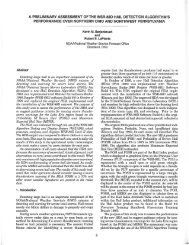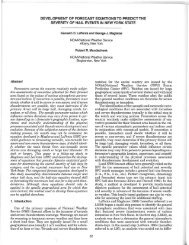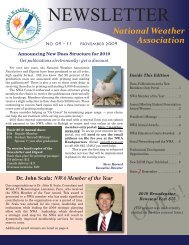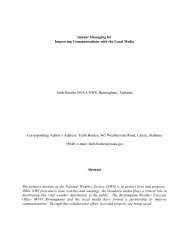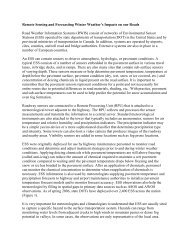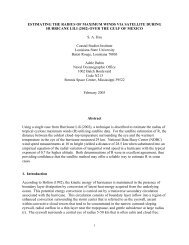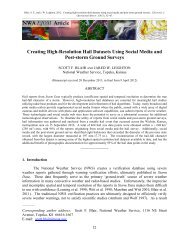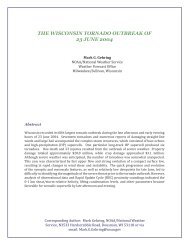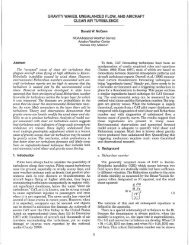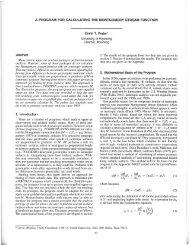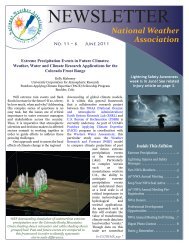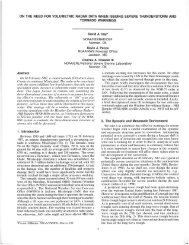MOS Precipitation Forecasts Formatted for the NDFD - National ...
MOS Precipitation Forecasts Formatted for the NDFD - National ...
MOS Precipitation Forecasts Formatted for the NDFD - National ...
You also want an ePaper? Increase the reach of your titles
YUMPU automatically turns print PDFs into web optimized ePapers that Google loves.
Huntemann, T. L., P. E. Shafer, K. K. Gilbert, M. R. Peroutka, 2012: <strong>MOS</strong> precipitation <strong>for</strong>ecasts <strong>for</strong>matted <strong>for</strong> <strong>the</strong> <strong>National</strong> Digital Forecast<br />
Database (<strong>NDFD</strong>). Preprints, 37th Natl. Wea. Assoc. Annual Meeting, Madison, WI, Natl. Wea. Assoc., P2.64.<br />
––––––––––––––––––––––––––––––––––––––––––––––––––––––––––––––––––––––––––––––––––––––––––––––––––––––––––––––––––––<br />
P2.64 <strong>MOS</strong> <strong>Precipitation</strong> <strong>Forecasts</strong> <strong>Formatted</strong> <strong>for</strong><br />
<strong>the</strong> <strong>National</strong> Digital Forecast Database (<strong>NDFD</strong>)<br />
TABITHA L. HUNTEMANN, PHILLIP E. SHAFER,<br />
KATHRYN K. GILBERT, MATTHEW R. PEROUTKA<br />
NOAA/<strong>National</strong> Wea<strong>the</strong>r Service, Meteorological Development Lab, Silver Spring, MD<br />
ABSTRACT<br />
The <strong>National</strong> Wea<strong>the</strong>r Service's Meteorological Development Laboratory (MDL) has issued<br />
gridded Model Output Statistics (gridded <strong>MOS</strong> or G<strong>MOS</strong>) guidance <strong>for</strong>ecasts <strong>for</strong> several years.<br />
G<strong>MOS</strong> guidance is available <strong>for</strong> most elements found in <strong>the</strong> <strong>National</strong> Digital Forecast Database<br />
(<strong>NDFD</strong>), including temperature, dewpoint, wind, and probabilistic guidance. These various <strong>for</strong>ms<br />
of gridded guidance are part of <strong>the</strong> <strong>National</strong> Digital Guidance Database (NDGD). An important<br />
element in <strong>the</strong> <strong>NDFD</strong> is <strong>the</strong> element named “wea<strong>the</strong>r.” It is sometimes called “predominant<br />
wea<strong>the</strong>r.” This element contains <strong>for</strong>ecasts of precipitation coverage or probability (e.g., scattered,<br />
chance, likely), precipitation type (e.g., rain, snow, ice pellets, thunder), precipitation intensity,<br />
obstruction to vision (e.g., fog), and a few o<strong>the</strong>r attributes. To date, gridded guidance <strong>for</strong> wea<strong>the</strong>r<br />
has not been available within NDGD. G<strong>MOS</strong> wea<strong>the</strong>r is being developed to support NWS<br />
Wea<strong>the</strong>r Forecast Offices (WFOs) as <strong>the</strong>y prepare <strong>the</strong> <strong>NDFD</strong>. G<strong>MOS</strong> wea<strong>the</strong>r interprets several<br />
G<strong>MOS</strong> elements to produce a guidance grid consistent with G<strong>MOS</strong> that also closely resembles <strong>the</strong><br />
<strong>NDFD</strong> wea<strong>the</strong>r <strong>for</strong>ecast.<br />
_______________<br />
1. Introduction<br />
<strong>National</strong> Wea<strong>the</strong>r Service <strong>for</strong>ecasters have<br />
used station-based <strong>MOS</strong> guidance as an aid<br />
<strong>for</strong> producing <strong>for</strong>ecast products issued to <strong>the</strong><br />
user community <strong>for</strong> many years.<br />
Requirements now prompt <strong>for</strong>ecasters to<br />
produce <strong>the</strong> official NWS 7-day <strong>for</strong>ecasts on<br />
high-resolution grids and <strong>MOS</strong> guidance has<br />
evolved to meet those needs. Gridded <strong>MOS</strong><br />
(G<strong>MOS</strong>) <strong>for</strong>ecasts have been developed <strong>for</strong><br />
many elements found in <strong>the</strong> <strong>National</strong> Digital<br />
Forecast Database (<strong>NDFD</strong>, Glahn and Ruth<br />
2003). The <strong>NDFD</strong> contains a seamless<br />
mosaic of high-resolution digital <strong>for</strong>ecasts<br />
from more than 120 field offices (Ruth and<br />
Glahn 2003). A variety of products is made<br />
from this database, including <strong>for</strong>ecast text,<br />
<strong>for</strong>ecast images at national and regional<br />
scales, and digital data compatible with<br />
Geographic In<strong>for</strong>mation Systems (GIS).<br />
The various <strong>for</strong>ms of G<strong>MOS</strong> guidance are<br />
part of <strong>the</strong> <strong>National</strong> Digital Guidance<br />
Database (NDGD, Glahn et al. 2009). The<br />
NDGD is a companion database to <strong>the</strong> <strong>NDFD</strong><br />
__________<br />
Corresponding author address: Tabitha L. Huntemann, Meteorological Development<br />
Laboratory, <strong>National</strong> Wea<strong>the</strong>r Service, 1325 East-West Highway, Silver Spring, MD 20910<br />
E-mail: tabitha.huntemann@noaa.gov
that contains guidance <strong>for</strong>ecasters may use as<br />
<strong>the</strong>y prepare official NWS <strong>for</strong>ecasts <strong>for</strong> <strong>the</strong><br />
<strong>NDFD</strong>. The G<strong>MOS</strong> guidance available in <strong>the</strong><br />
NDGD <strong>for</strong> <strong>NDFD</strong> products includes<br />
temperature, dewpoint, wind, and probabilistic<br />
elements. To date, gridded guidance <strong>for</strong> <strong>the</strong><br />
<strong>NDFD</strong> element “wea<strong>the</strong>r” has not been<br />
available within <strong>the</strong> NDGD. This element<br />
contains <strong>for</strong>ecasts of precipitation coverage or<br />
probability (e.g., scattered, chance, likely),<br />
precipitation type (e.g., rain, snow, ice pellets,<br />
thunder), precipitation intensity, obstruction to<br />
vision (e.g., fog), and a few o<strong>the</strong>r attributes<br />
(NWS 2009). A G<strong>MOS</strong> wea<strong>the</strong>r grid is being<br />
developed to support NWS Wea<strong>the</strong>r Forecast<br />
Offices (WFOs) as <strong>the</strong>y prepare <strong>the</strong> <strong>NDFD</strong>.<br />
Here, we present a method that uses a<br />
collection of G<strong>MOS</strong> <strong>for</strong>ecasts to generate<br />
several precipitation grids to support <strong>the</strong><br />
G<strong>MOS</strong> wea<strong>the</strong>r grid. The resulting<br />
precipitation probability, type, and intensity<br />
grids are combined to generate G<strong>MOS</strong><br />
wea<strong>the</strong>r guidance. Though <strong>the</strong>re is not<br />
currently a G<strong>MOS</strong> obstruction to visibility<br />
grid to support that component of <strong>the</strong> wea<strong>the</strong>r<br />
element, <strong>the</strong> G<strong>MOS</strong> wea<strong>the</strong>r grid remains<br />
useful without it. We expect <strong>the</strong>se grids will<br />
be valuable to <strong>for</strong>ecasters at NWS WFOs and<br />
throughout <strong>the</strong> wea<strong>the</strong>r enterprise.<br />
2. Data and methods<br />
GFS-based <strong>MOS</strong> grids are produced at<br />
2.5-km resolution over <strong>the</strong> conterminous<br />
United States (CONUS) from <strong>the</strong> 0000 and<br />
1200 UTC GFS model runs. A collection of<br />
G<strong>MOS</strong> <strong>for</strong>ecasts is used to generate<br />
precipitation probability, type, and intensity<br />
grids to support <strong>the</strong> <strong>MOS</strong> wea<strong>the</strong>r grid as<br />
listed in Table 1. The resulting precipitation<br />
grids are <strong>the</strong>n combined to create G<strong>MOS</strong><br />
wea<strong>the</strong>r.<br />
Probability of precipitation occurrence<br />
during 3-hourly intervals (PoPO3) uses <strong>the</strong><br />
standard METAR observations valid at any<br />
one of <strong>the</strong> four hourly observations defining<br />
<strong>the</strong> 3-h interval to define <strong>the</strong> predictand<br />
(Dallavalle et al. 2005). The observations of<br />
present wea<strong>the</strong>r at <strong>the</strong> relevant hours are<br />
exclusively used to define <strong>the</strong> PoPO3<br />
predictand. This is in contrast to <strong>the</strong><br />
probability of precipitation (PoP), which<br />
requires measurable precipitation (greater than<br />
0.01 inches of liquid-equivalent precipitation)<br />
over an interval of time (6 or 12 hours) <strong>for</strong> an<br />
event to occur (Maloney 2002). The PoP and<br />
precipitation amount predictand in<strong>for</strong>mation<br />
are obtained from 6-h precipitation amounts in<br />
Hydrologic Rainfall Analysis Project (HRAP)<br />
4-km grid boxes, as specified in qualitycontrolled<br />
River Forecast Center Stage III<br />
precipitation analyses (Charba and<br />
Samplatsky 2011).<br />
Similar to PoPO3, <strong>the</strong> conditional<br />
probabilities of precipitation type are derived<br />
from hourly METAR observations of present<br />
wea<strong>the</strong>r. Considering only cases when<br />
precipitation of some <strong>for</strong>m is observed, each<br />
observation is classified into one of three<br />
mutually exclusive categories to define <strong>the</strong><br />
predictand: freezing, frozen, or liquid.<br />
Gridded climatologies and logit 50% values<br />
are used as predictors in a generalized<br />
operator equation development to capture<br />
localized effects and enhanced terrain detail<br />
(Shafer 2010). These probabilities are<br />
conditional on precipitation occurring.<br />
G<strong>MOS</strong> thunderstorm guidance defines a<br />
thunderstorm as <strong>the</strong> occurrence of one or more<br />
cloud-to-ground lightning strikes within a 40-<br />
km grid box during a given time period<br />
(Shafer and Gilbert 2008). G<strong>MOS</strong> severe<br />
thunderstorm <strong>for</strong>ecasts indicate <strong>the</strong> probability<br />
of a report of tornadoes, large hail, or<br />
thunderstorm wind gusts within an 80-km grid<br />
box during <strong>the</strong> given time period. The<br />
unconditional severe probabilities are<br />
computed from <strong>the</strong> product of <strong>the</strong> conditional<br />
probability of a severe thunderstorm and <strong>the</strong><br />
2
probability of a thunderstorm in each 80-km<br />
grid box.<br />
a. <strong>Precipitation</strong> potential index<br />
<strong>Precipitation</strong> potential index (PPI)<br />
supports <strong>the</strong> generation of <strong>NDFD</strong> PoP12<br />
<strong>for</strong>ecasts and <strong>the</strong> categorical in<strong>for</strong>mation<br />
provided by <strong>the</strong> <strong>NDFD</strong> wea<strong>the</strong>r grids (NWS<br />
2009). PPI values range from 0 to 100 and<br />
resemble PoP12 values in magnitude. The<br />
PoP12 <strong>for</strong> any 12-hour period can be derived<br />
by taking <strong>the</strong> maximum PPI value within <strong>the</strong><br />
desired period. PPI is not a probability<br />
<strong>for</strong>ecast, which has different statistical<br />
characteristics. For example, as temporal<br />
resolution increases probability should<br />
decrease (i.e., 12-hour PoP <strong>for</strong>ecasts will have<br />
a larger magnitude than 6-h PoP <strong>for</strong>ecasts).<br />
As temporal resolution increases, <strong>the</strong><br />
magnitude of PPI is unaffected.<br />
We generate PPI from G<strong>MOS</strong> <strong>for</strong>ecasts of<br />
PoPO3 (Fig. 1a), PoP6, and PoP12. We <strong>the</strong>n<br />
use PPI to assign <strong>the</strong> precipitation probability<br />
(Fig. 1b) as slight chance (SChc), chance<br />
(Chc), likely (Lkly), or definite (Def). Darker<br />
shades in <strong>the</strong> wea<strong>the</strong>r grid image (Fig. 1c)<br />
indicate higher precipitation probability. The<br />
<strong>NDFD</strong> wea<strong>the</strong>r grid commonly treats<br />
probability and areal coverage as<br />
interchangeable expressions of uncertainty.<br />
Though strictly speaking this is not true, this<br />
compromise allows <strong>NDFD</strong> grids to convey <strong>the</strong><br />
same in<strong>for</strong>mation traditionally expressed in<br />
NWS worded <strong>for</strong>ecasts. G<strong>MOS</strong> wea<strong>the</strong>r<br />
approximates <strong>the</strong> <strong>NDFD</strong> approach by using<br />
probabilistic terms with precipitation types<br />
and areal coverage with thunderstorms and<br />
severe thunderstorms to communicate<br />
uncertainty (Table 2).<br />
b. <strong>Precipitation</strong> type<br />
Multiple precipitation types may be<br />
present in <strong>the</strong> wea<strong>the</strong>r grid (e.g., “definite rain<br />
and chance of snow”). We use PPI,<br />
temperature, and conditional probabilities of<br />
freezing, frozen, and liquid precipitation to<br />
determine <strong>the</strong> precipitation probability <strong>for</strong><br />
each of freezing, frozen, and liquid<br />
precipitation types. Figure 2 shows <strong>the</strong><br />
progression from conditional probability of<br />
freezing precipitation (Fig. 2a) to freezing<br />
category (Fig. 2b) to wea<strong>the</strong>r (Fig. 2c). The<br />
resulting wea<strong>the</strong>r grid often contains hundreds<br />
of unique combinations of probability<br />
categories and precipitation types. The<br />
graphical representations of <strong>the</strong> wea<strong>the</strong>r grid<br />
greatly simplify this in<strong>for</strong>mation into about a<br />
dozen colors in order to create an easily<br />
interpreted image from this complex element.<br />
The colors (green, blue, pink, etc.) in <strong>the</strong><br />
wea<strong>the</strong>r grid image indicate <strong>the</strong> most likely<br />
precipitation types. “Mix” indicates<br />
combinations of liquid and frozen<br />
precipitation (i.e., rain and snow) and “Ice”<br />
indicates combinations that include freezing<br />
precipitation (i.e., sleet or freezing rain). This<br />
simplification is illustrated in Fig. 2. The<br />
wea<strong>the</strong>r grid in central Wisconsin and<br />
sou<strong>the</strong>rn Michigan contains freezing<br />
precipitation as indicated in Fig. 2b, but liquid<br />
and frozen precipitation are more likely in<br />
those areas so “Mix” is displayed in Fig. 2c.<br />
c. Thunderstorms and severe thunderstorms<br />
<strong>Precipitation</strong> type may also include<br />
thunderstorm and severe thunderstorm<br />
categories, which we generate from a<br />
combination of PPI, TSTM3, TSTM6,<br />
TSTM12, TSVR3 and TSVR12. As part of<br />
<strong>the</strong> simplification of <strong>the</strong> wea<strong>the</strong>r grid to an<br />
image, thunderstorms are grouped under <strong>the</strong><br />
colors <strong>for</strong> “Rain” and only severe<br />
thunderstorm categories of scattered or higher<br />
are displayed on <strong>the</strong> wea<strong>the</strong>r grid. Figure 3a<br />
shows a large area of 3-h probabilities of<br />
thunderstorms exceeding 40% over <strong>the</strong> central<br />
Mississippi valley. Figure 3b shows a more<br />
localized area of isolated and scattered severe<br />
thunderstorms. Figure 3c shows high<br />
probabilities of “Rain” (dark green) over <strong>the</strong><br />
3
areas of higher thunderstorm potential and<br />
shows “Severe” (red) over <strong>the</strong> area of<br />
scattered severe thunderstorms.<br />
d. <strong>Precipitation</strong> intensity<br />
<strong>Precipitation</strong> intensity is obtained from <strong>the</strong><br />
6-h Quantitative <strong>Precipitation</strong> Forecast<br />
(QPF6). The default intensity is light, though<br />
moderate intensity is triggered by QPF6<br />
exceeding 0.5" and heavy intensity is<br />
triggered by QPF6 exceeding 1".<br />
<strong>Precipitation</strong> intensity is not indicated on <strong>the</strong><br />
simplified wea<strong>the</strong>r grid images.<br />
3. Analysis<br />
From 28 Feb to 1 Mar 2012, a major<br />
winter storm impacted <strong>the</strong> north central to<br />
nor<strong>the</strong>astern U.S. (Otto 2012). It produced<br />
heavy snow and blizzard conditions along<br />
with some accumulations of sleet and freezing<br />
rain. In addition, <strong>the</strong>re were hundreds of<br />
severe wea<strong>the</strong>r reports from <strong>the</strong> Central Plains<br />
to <strong>the</strong> Central Appalachians on <strong>the</strong> warmer<br />
side of this storm system. The “a” panels of<br />
Figs. 4-7 contain <strong>for</strong>ecast maps of 33-h<br />
G<strong>MOS</strong> elements <strong>for</strong> 0000 UTC 28 Feb 2012.<br />
The “b” panels contain <strong>for</strong>ecast maps of 30-h<br />
<strong>NDFD</strong> elements <strong>for</strong> 0600 UTC 28 Feb 2012.<br />
The G<strong>MOS</strong> and <strong>NDFD</strong> <strong>for</strong>ecasts are all valid<br />
0900 UTC 29 Feb 2012.<br />
a. <strong>Precipitation</strong> potential index<br />
G<strong>MOS</strong> PPI and <strong>NDFD</strong> PPI are shown in<br />
Fig. 4. Both <strong>for</strong>ecasts have similar areal<br />
coverage and magnitude. The dominant<br />
feature in both is <strong>the</strong> area of precipitation<br />
associated with <strong>the</strong> winter storm over <strong>the</strong><br />
central U.S. Discontinuities are apparent in<br />
<strong>NDFD</strong> along WFO boundaries. The low PPI<br />
values over Colorado and Wyoming result in<br />
G<strong>MOS</strong> wea<strong>the</strong>r <strong>for</strong>ecasts of “no wea<strong>the</strong>r” <strong>for</strong><br />
those areas.<br />
b. Wea<strong>the</strong>r<br />
G<strong>MOS</strong> products are intended to be<br />
guidance <strong>for</strong> <strong>NDFD</strong> <strong>for</strong>ecasts, so it is<br />
reasonable to compare G<strong>MOS</strong> wea<strong>the</strong>r to<br />
<strong>NDFD</strong> wea<strong>the</strong>r. In this case, <strong>the</strong> <strong>NDFD</strong><br />
issuance time chosen was selected because it<br />
roughly corresponds to when G<strong>MOS</strong> guidance<br />
is expected to have been available to<br />
<strong>for</strong>ecasters. This means <strong>the</strong> <strong>NDFD</strong> wea<strong>the</strong>r<br />
<strong>for</strong>ecast has <strong>the</strong> potential to contain<br />
in<strong>for</strong>mation from several of <strong>the</strong> G<strong>MOS</strong><br />
products used to determine G<strong>MOS</strong> wea<strong>the</strong>r.<br />
This comparison does not verify <strong>the</strong> G<strong>MOS</strong><br />
<strong>for</strong>ecast, but will indicate <strong>the</strong> utility of <strong>the</strong><br />
NDGD <strong>for</strong>ecasts in <strong>the</strong> overall <strong>for</strong>ecast<br />
process. There are no gridded present wea<strong>the</strong>r<br />
observations available; however station-based<br />
METAR observations of present wea<strong>the</strong>r can<br />
be used to subjectively evaluate G<strong>MOS</strong><br />
wea<strong>the</strong>r <strong>for</strong>ecasts.<br />
Figure 5a shows <strong>the</strong> G<strong>MOS</strong> wea<strong>the</strong>r 33-h<br />
<strong>for</strong>ecast from <strong>the</strong> 0000 UTC cycle on<br />
28 Feb 2012 valid <strong>for</strong> 0900 UTC 29 Feb 2012.<br />
Figure 5b shows <strong>the</strong> <strong>NDFD</strong> wea<strong>the</strong>r 30-h<br />
<strong>for</strong>ecast from 0600 UTC 28 Feb 2012 valid at<br />
<strong>the</strong> same time. Both panels are plotted with<br />
METAR observations <strong>for</strong> <strong>the</strong> valid time of<br />
0900 UTC 29 Feb 2012. It is evident that <strong>the</strong><br />
G<strong>MOS</strong> probability categories (areas of light<br />
and dark shading) generally correspond well<br />
to <strong>the</strong> <strong>NDFD</strong> <strong>for</strong>ecast. Both G<strong>MOS</strong> and<br />
<strong>NDFD</strong> wea<strong>the</strong>r resemble METAR<br />
observations. Over Michigan’s Upper<br />
Peninsula, one can see fewer METAR present<br />
wea<strong>the</strong>r observations occur where <strong>the</strong> G<strong>MOS</strong><br />
precipitation probability is lower. In general,<br />
both rain and snow are observed in “Mix”,<br />
rain in “Rain” and snow in “Snow”. G<strong>MOS</strong><br />
has larger areas of “Ice” and “Mix” that are<br />
supported by observations. The two ice<br />
<strong>for</strong>ecasts at this valid time are observed over<br />
central Wisconsin, outside of <strong>the</strong> <strong>NDFD</strong> areas<br />
of “Ice”. However, G<strong>MOS</strong> has a much<br />
broader swath of “Ice” that is not supported by<br />
<strong>the</strong> observations. Due to <strong>the</strong> simplifying<br />
4
assumptions used to generate <strong>the</strong> wea<strong>the</strong>r<br />
images, one cannot tell from Figure 5 whe<strong>the</strong>r<br />
<strong>the</strong> G<strong>MOS</strong> “Ice” <strong>for</strong>ecasts at those points<br />
contain “Definite snow, slight chance sleet” or<br />
“Definite sleet, slight chance snow” or a<br />
different combination containing freezing<br />
precipitation.<br />
Figure 6 shows G<strong>MOS</strong> and <strong>NDFD</strong><br />
wea<strong>the</strong>r <strong>for</strong>ecasts <strong>for</strong> <strong>the</strong> same time as Fig. 5<br />
plotted with METAR observations <strong>for</strong> <strong>the</strong><br />
valid time of 0900 UTC 29 Feb 2012. While<br />
severe reports can be sparse in “Severe” areas<br />
of <strong>the</strong> wea<strong>the</strong>r grid, <strong>the</strong> G<strong>MOS</strong> guidance <strong>for</strong><br />
<strong>the</strong> red area rarely exceeds <strong>the</strong> low-probability<br />
<strong>for</strong>ecast of “chance of severe thunderstorms.”<br />
For this particular severe event, both <strong>the</strong><br />
G<strong>MOS</strong> and <strong>NDFD</strong> <strong>for</strong>ecasts made more than a<br />
day in advance failed to correctly locate where<br />
severe wea<strong>the</strong>r would occur. Determining <strong>the</strong><br />
location of severe wea<strong>the</strong>r a day or more in<br />
advance is a difficult task and it is anticipated<br />
that incorporating severe wea<strong>the</strong>r is an area<br />
where <strong>for</strong>ecasters will add value to <strong>the</strong> G<strong>MOS</strong><br />
wea<strong>the</strong>r guidance.<br />
The G<strong>MOS</strong> and <strong>NDFD</strong> wea<strong>the</strong>r <strong>for</strong>ecasts<br />
<strong>for</strong> <strong>the</strong> entire CONUS are shown in Fig. 7.<br />
G<strong>MOS</strong> lacks some coverage over <strong>the</strong> eastern<br />
Great Lakes. In <strong>the</strong> Mountain West, G<strong>MOS</strong><br />
wea<strong>the</strong>r lacks both coverage and detail over<br />
<strong>the</strong> mountainous terrain. The lack of coverage<br />
and detail in <strong>the</strong> G<strong>MOS</strong> PoP and QPF grids is<br />
a chronic issue resulting in part from short<br />
development samples and <strong>the</strong> irregular<br />
distribution of <strong>MOS</strong> stations over <strong>the</strong> <strong>for</strong>ecast<br />
domain (Charba and Samplatsky 2011). But<br />
overall, G<strong>MOS</strong> precipitation types (green,<br />
blue, pink, and purple colors) correspond well<br />
to <strong>the</strong> <strong>NDFD</strong> <strong>for</strong>ecast. The <strong>NDFD</strong><br />
predominant wea<strong>the</strong>r grid contains areas of<br />
fog in sou<strong>the</strong>rn Texas and Florida. Because<br />
<strong>the</strong>re is not yet G<strong>MOS</strong> guidance <strong>for</strong><br />
obstruction to vision, <strong>the</strong> G<strong>MOS</strong> predominant<br />
wea<strong>the</strong>r grid does not contain <strong>for</strong>ecasts <strong>for</strong> fog<br />
in <strong>the</strong>se areas.<br />
4. Products and future work<br />
G<strong>MOS</strong> wea<strong>the</strong>r guidance will be produced<br />
on a 2.5-km grid over <strong>the</strong> CONUS. Though<br />
<strong>the</strong>re is no current <strong>MOS</strong> obstruction to vision<br />
grid to support that component of <strong>the</strong> wea<strong>the</strong>r<br />
element, G<strong>MOS</strong> wea<strong>the</strong>r remains useful<br />
without it. Guidance will be available in<br />
NDGD at 0000 UTC and 1200 UTC cycles <strong>for</strong><br />
projections every 3 hours from 6 to 192 hours.<br />
The anticipated implementation date is late<br />
2013.<br />
Work is underway to expand guidance to a<br />
3-km grid over Alaska. G<strong>MOS</strong> wea<strong>the</strong>r <strong>for</strong><br />
Alaska will also be available in NDGD at<br />
0000 UTC and 1200 UTC cycles <strong>for</strong><br />
projections every 3 hours from 6 to 192 hours.<br />
Many G<strong>MOS</strong> elements available at 2.5-km<br />
resolution over <strong>the</strong> CONUS are also available<br />
<strong>for</strong> a 3-km grid over Alaska. A few, like<br />
probability of thunderstorms and <strong>the</strong><br />
conditional probabilities of precipitation type,<br />
have different seasonal availability over <strong>the</strong><br />
CONUS and Alaska.<br />
MDL is developing methods to objectively<br />
verify both G<strong>MOS</strong> and <strong>NDFD</strong> wea<strong>the</strong>r grids.<br />
These techniques extract wea<strong>the</strong>r <strong>for</strong>ecasts at<br />
METAR stations from grids and compare <strong>the</strong><br />
<strong>for</strong>ecasts to observations at those stations.<br />
Preliminary results indicate G<strong>MOS</strong> and<br />
<strong>NDFD</strong> have similar scores <strong>for</strong> probability of<br />
detection, false alarm ratio, and critical<br />
success index.<br />
5. Conclusions<br />
A credible <strong>MOS</strong> wea<strong>the</strong>r grid over <strong>the</strong><br />
CONUS has been developed to support NWS<br />
WFOs. It contains important probabilistic<br />
in<strong>for</strong>mation about winter wea<strong>the</strong>r and severe<br />
wea<strong>the</strong>r. G<strong>MOS</strong> wea<strong>the</strong>r guidance per<strong>for</strong>ms<br />
well when compared to observations and<br />
emulates <strong>NDFD</strong> wea<strong>the</strong>r with respect to<br />
precipitation type and probability.<br />
5
The <strong>NDFD</strong> is designed to contain a<br />
seamless mosaic of high-resolution digital<br />
<strong>for</strong>ecasts from more than 120 field offices<br />
(Glahn and Ruth 2003). G<strong>MOS</strong> guidance can<br />
assist <strong>for</strong>ecasters with collaboration across<br />
WFO boundaries. Forecasters add value to<br />
<strong>the</strong> guidance by interpreting external<br />
in<strong>for</strong>mation and inserting precipitation types<br />
and attributes <strong>the</strong> <strong>MOS</strong> wea<strong>the</strong>r grid does not<br />
yet <strong>for</strong>ecast (obstruction to vision, dry<br />
thunderstorms, hail, and o<strong>the</strong>rs). We expect<br />
<strong>the</strong>se grids will be valuable to <strong>for</strong>ecasters at<br />
NWS WFOs and throughout <strong>the</strong> wea<strong>the</strong>r<br />
enterprise.<br />
Acknowledgements. The authors would like to<br />
thank David Ruth <strong>for</strong> his insightful comments<br />
about <strong>the</strong> wea<strong>the</strong>r grid and Geoff Wagner <strong>for</strong><br />
his expertise with G<strong>MOS</strong> products.<br />
REFERENCES<br />
Charba, J.P., and F.G. Samplatsky, 2011: High<br />
resolution GFS-based <strong>MOS</strong> quantitative<br />
precipitation <strong>for</strong>ecasts on a 4-km grid.<br />
Mon. Wea. Rev., 139, 39-68. [Available<br />
online at<br />
http://journals.ametsoc.org/doi/pdf/10.117<br />
5/2010MWR3224.1.]<br />
Dallavalle, J. P., and Glahn, B., 2005: Toward<br />
a Gridded <strong>MOS</strong> System. Preprints, 21st<br />
Conference on Wea<strong>the</strong>r Analysis and<br />
Forecasting, Washington, D.C., Amer.<br />
Meteor. Soc, 13B.2. [Available online at<br />
http://ams.confex.com/ams/pdfpapers/949<br />
98.pdf.]<br />
Glahn, B., K. Gilbert, R. Cosgrove, D. P.<br />
Ruth, and K. Sheets, 2009: The gridding<br />
of <strong>MOS</strong>. Wea. Forecasting, 24, 520-529.<br />
[Available online at<br />
http://journals.ametsoc.org/doi/abs/10.117<br />
5/2008WAF2007080.1.]<br />
Glahn, H. R., and D. P. Ruth, 2003: The new<br />
digital <strong>for</strong>ecast database of <strong>the</strong> <strong>National</strong><br />
Wea<strong>the</strong>r Service. Bull. Amer. Meteor.<br />
Soc., 84, 195-201. [Available online at<br />
http://journals.ametsoc.org/doi/abs/10.117<br />
5/BAMS-84-2-195.]<br />
Maloney, J. C., 2002: Eta-based <strong>MOS</strong><br />
probability of precipitation (PoP) and<br />
quantitative precipitation <strong>for</strong>ecast (QPF)<br />
guidance <strong>for</strong> <strong>the</strong> continental United States.<br />
NWS Technical Procedures Bulletin No.<br />
487, <strong>National</strong> Oceanic and Atmospheric<br />
Administration, U.S. Department of<br />
Commerce, 22 pp. [Available online at<br />
http://www.nws.noaa.gov/mdl/pubs/Docu<br />
ments/TechProcBulls/487.pdf.]<br />
NWS, 2009: <strong>National</strong> Digital Forecast<br />
Database and Local Database Description<br />
and Specification. <strong>National</strong> Wea<strong>the</strong>r<br />
Service Instruction 10-201, 22 pp.<br />
[Available online at<br />
http://www.nws.noaa.gov/directives/sym/p<br />
d01002001curr.pdf, cited 2011.]<br />
Otto, R., cited 2012: Upper Midwest to New<br />
England Winter Storm – February 28 –<br />
March 1, 2012. [Available online at<br />
http://www.hpc.ncep.noaa.gov/winter_stor<br />
m_summaries/event_reviews/2012/Upper_<br />
Midwest_to_New_England_Winter_Storm<br />
_FebMar2012.pdf.]<br />
Ruth, D. P., and H. R. Glahn, 2003: Creating a<br />
national digital <strong>for</strong>ecast database of<br />
official <strong>National</strong> Wea<strong>the</strong>r Service<br />
<strong>for</strong>ecasts, Preprints, 19th International<br />
Conference on Interactive In<strong>for</strong>mation and<br />
Processing Systems <strong>for</strong> Meteorology,<br />
Oceanography, and Hydrology, Long<br />
Beach, CA, Amer. Meteor. Soc., 12.1.<br />
[Available online at<br />
http://www.nws.noaa.gov/mdl/pubs/Docu<br />
ments/Papers/Ruth2003Creating.pdf.]<br />
Shafer, P., and K. Gilbert, 2008: Developing<br />
GFS-Based <strong>MOS</strong> thunderstorm guidance<br />
<strong>for</strong> Alaska. Preprints, Third Conf. on<br />
6
Meteorological Applications of Lightning<br />
Data, New Orleans, LA, Amer. Meteor.<br />
Soc., P2.9. [Available online at<br />
https://ams.confex.com/ams/pdfpapers/131<br />
190.pdf.]<br />
Shafer, P. E., 2010: Logit trans<strong>for</strong>ms in<br />
<strong>for</strong>ecasting precipitation type. Preprints,<br />
20th Conf. on Probability and Statistics in<br />
<strong>the</strong> Atmospheric Sciences, Atlanta, GA,<br />
Amer. Meteor. Soc. [Available online at<br />
https://ams.confex.com/ams/pdfpapers/158<br />
479.pdf.]<br />
7
Table 1. G<strong>MOS</strong> elements used to generate <strong>the</strong> <strong>MOS</strong> wea<strong>the</strong>r grid.<br />
G<strong>MOS</strong> Element<br />
3-h Probability of <strong>Precipitation</strong> Occurrence<br />
(PoPO3)<br />
6- and 12-h Probability of <strong>Precipitation</strong><br />
(PoP6, PoP12)<br />
Temperature<br />
Conditional Probability of Freezing<br />
<strong>Precipitation</strong> (POZR)<br />
Conditional Probability of Frozen<br />
<strong>Precipitation</strong> (POFR)<br />
Conditional Probability of Liquid<br />
<strong>Precipitation</strong> (PORA)<br />
6-h Quantitative <strong>Precipitation</strong> Forecast<br />
(QPF6)<br />
3-, 6-, and 12-h Probability of a<br />
Thunderstorm (TSTM3, TSTM6, TSTM12)<br />
3- and 12-h Unconditional Probability of a<br />
Severe Thunderstorm (TSVR3, TSVR12)<br />
Wea<strong>the</strong>r Component<br />
<strong>Precipitation</strong> probability<br />
<strong>Precipitation</strong> probability<br />
<strong>Precipitation</strong> type<br />
<strong>Precipitation</strong> type<br />
<strong>Precipitation</strong> type<br />
<strong>Precipitation</strong> type<br />
<strong>Precipitation</strong> intensity<br />
Thunder probability<br />
Severe probability<br />
Table 2. <strong>Precipitation</strong> potential indices and associated categories.<br />
<strong>Precipitation</strong> Potential<br />
Index<br />
Probability Category<br />
(<strong>for</strong> precipitation types)<br />
Coverage Category<br />
(<strong>for</strong> thunder and<br />
severe)<br />
0-14 None None<br />
15-24 Slight Chance (SChc) Isolated (Iso)<br />
25-54 Chance (Chc) Scattered (Sct)<br />
55-74 Likely (Lkly) Numerous (Num)<br />
75-100 Definite (Def) Definite (Def)<br />
8
Figure 1. 0000 UTC 28 Feb 2012 33-h <strong>for</strong>ecasts of G<strong>MOS</strong> (a) PoPO3 (in percent), (b) PPI, and<br />
(c) wea<strong>the</strong>r (valid 0900 UTC 29 Feb 2012).<br />
Figure 2. 0000 UTC 28 Feb 2012 33-h <strong>for</strong>ecasts of G<strong>MOS</strong> (a) POZR (in percent),<br />
(b) freezing category, and (c) wea<strong>the</strong>r (valid 0900 UTC 29 Feb 2012).<br />
9
Figure 3. 0000 UTC 28 Feb 2012 33-h <strong>for</strong>ecasts of G<strong>MOS</strong> (a) TSTM3 (in percent),<br />
(b) severe category, and (c) wea<strong>the</strong>r (valid 0900 UTC 29 Feb 2012).<br />
Figure 4. (a) 33-h G<strong>MOS</strong> PPI <strong>for</strong> 0000 UTC 28 Feb 2012 (b) 30-h <strong>NDFD</strong> PPI <strong>for</strong><br />
0600 UTC 28 Feb 2012. (Both <strong>for</strong>ecasts valid 0900 UTC 29 Feb 2012.)<br />
10
Figure 5. (a) 33-h G<strong>MOS</strong> PPI 0000 UTC 28 Feb 2012 (b) 30-h <strong>NDFD</strong> PPI 0600 UTC<br />
28 Feb 2012. Corresponding METAR observations <strong>for</strong> <strong>the</strong> valid time of 0900 UTC 29 Feb 2012<br />
are also plotted.<br />
Figure 6. (a) 33-h G<strong>MOS</strong> wea<strong>the</strong>r <strong>for</strong> 0000 UTC 28 Feb 2012 (b) 30-h <strong>NDFD</strong> wea<strong>the</strong>r <strong>for</strong><br />
0600 UTC 28 Feb 2012. SPC storm reports from 0600-0900 UTC 29 Feb 2012 and METAR<br />
observations from 0900 UTC 29 Feb 2012 are also plotted.<br />
11
Figure 7. (a) 33-h G<strong>MOS</strong> wea<strong>the</strong>r <strong>for</strong> 0000 UTC 28 Feb 2012 (b) 30-h <strong>NDFD</strong> wea<strong>the</strong>r <strong>for</strong><br />
0600 UTC 28 Feb 2012. (Both <strong>for</strong>ecasts valid 0900 UTC 29 Feb 2012.)<br />
12



